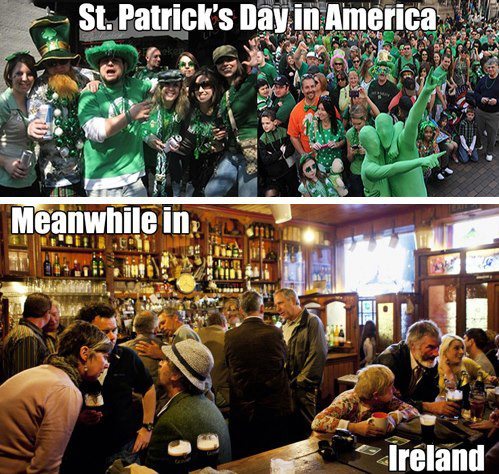St. Patrick’s Day: US vs Ireland & Origins

St. Patrick’s Day is upon us, and it’s easy to think of some of the things people will be doing around Boston. St. Patrick’s Day in America tends to be a pretty big deal, a day full of parades, parties and leprechauns. A day where everyone pretends to be Irish, wear green, and all the adults drink beer. This is how we have come to celebrate St. Patrick’s Day: a day of the Irish.
However, if you were to “hop across the pond” to Ireland, you might see that we haven’t been interpreting the day the same here in America. Ironically enough, St. Patrick’s Day is often thought of as an Irish holiday, despite the fact that it is a much bigger deal in America. One big tradition for the feast day is a parade, full of Irish-themed floats and green people everywhere. However, in Ireland, parades are usually only held to attract tourists, and even if they are held they focus around more traditional ways of performing. In America, St. Patty’s Day is often associated with drinking; however, up until the 1970s in Ireland, pubs remained closed on St. Patrick’s Day. In America, St. Patrick’s Day has a lot of superstitions about leprechauns; however, fairies played a larger part in ancient Irish culture.
A typical St. Patrick’s Day meal in America is corn beef hash and cabbage. However, this is only because Irish immigrants originally could not afford the kind of meat used in a regular Irish Breakfast, so they had to opt for a less expensive meat to remind them of home. Lastly, in America, St. Patrick’s Day has lost its meaning. St. Patrick’s Day in Ireland usually consists of attending mass and participating in more spiritual activities to respect the saint’s feast day. In America, St. Patrick’s Day has become a secular day where you focus more on material goods than your faith. I think that as we celebrate St. Patrick’s Day today, it’s great that we have fun—but it’s also important to keep the true meaning close to our hearts.
Who was St. Patrick?
Ireland has three recognized patron saints: Saint Columba, Saint Brigid and Saint Patrick. On March 17th, people around the world gather to celebrate one of Ireland’s three patron saints: Saint Patrick. Saint Patrick is thought to have been born around 387 AD and to have died around 460 AD. As a young teen, Saint Patrick was captured by pirates and sold into slavery in Ireland for 6 years. There, he worked in the fields and prayed often. After his enslavement, he escaped and became a priest and later a bishop. He was called to teach Christianity to the Irish people and set out to convert the people of Ireland and rebuild their churches.
Although Saint Patrick mainly worked in Ireland, we celebrate St. Patrick’s Day here in America alongside the rest of the world. The tradition is thought to have come to America with Irish immigrants as a way to maintain their heritage. At Montrose, some girls participate in Irish step dancing and we have mass dedicated to Saint Patrick on St. Patrick’s Day. Meagan Flynn ‘19 shares her love of Irish step dancing with others on St. Patrick’s Day: “I am an irish dancer but out with an injury. I usually go around with my dance school, Harney Pender-Keady, to different restaurants and schools for a dance out in my solo dress. This is my favorite time of the year because I love to show off my dancing and this irish holiday! (I miss it!).”
In a few Montrose families, families have parties, wear green and sometimes leprechauns turn the milk green for breakfast. Mrs. Baker described what happens in her family for St. Patrick’s Day: “Leprechauns always turn the Baker family milk green. Other than that, March 17 often falls during Spirit Days so wearing of the green is in order.” Today in America, we celebrate with parties, shamrocks, leprechauns and traditional Irish food. Although St. Patrick’s Day falls on a lenten Friday this year, Cardinal O’Malley gave his blessing for the people in the Boston diocese to eat corned beef! Happy St. Patrick’s Day!










